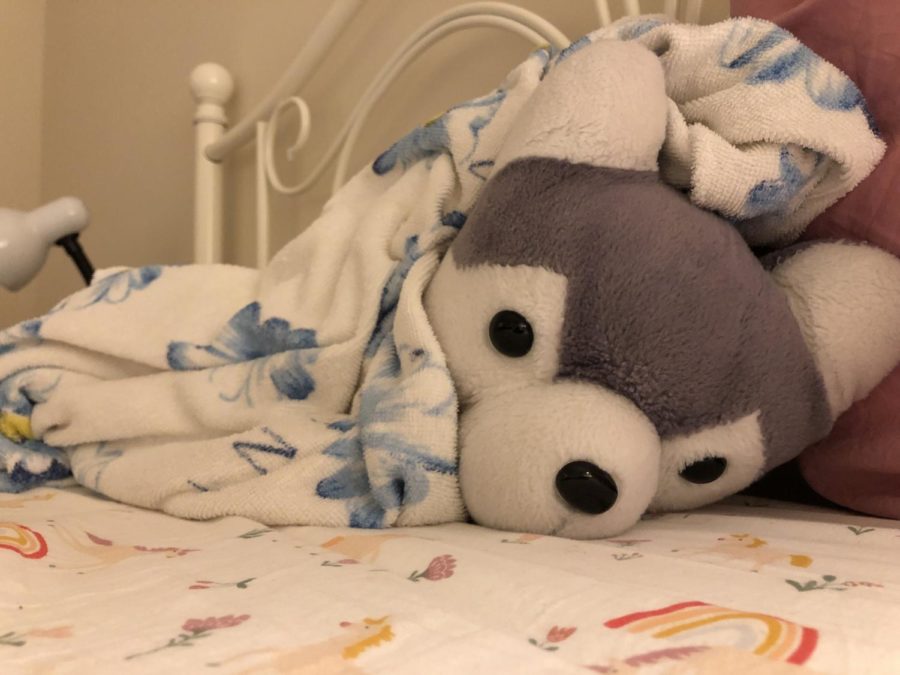Stuffed animals for teens soften stress, should be normalized
Hachi, a student’s beloved stuffed dog of ten years, lays swaddled on its owner’s bed. Special stuffed animals can earn a permanent place in one’s heart and household; in a Build-a-Bear survey, 72% of respondents said they planned to keep their favorite plush toy forever.
March 24, 2023
In the trudge through third quarter’s frigid weeks toward the hectic pressure of finals galore, many students find comfort in close companions who support them throughout the school day. While most of these supporters are fellow students, I’ve been accompanied on my most stressful days by a tiny purple axolotl named Ariel.
As this cozy stuffed critter swam from class to class with me on his first school visit, each student I passed along the way seemed to comment on him. Whether adoring, condescending or confused, their reactions to Ariel showed that his presence in an academic setting, alongside a high school senior no less, was out of the ordinary; however, my plush partner in crime should be regarded as no more unusual than his unique species.
Teen mental health issues are ever growing, and adolescents experienced an increase in significant distress, depression and suicidal thoughts over the course of the 2010s, largely associated with the rise of social media, per the American Psychological Association (APA). The isolation and stress of COVID-19 only intensified mental health concerns, and in 2022, 44% of high school students reported consistent feelings of sadness and hopelessness, according to the CDC. With exam season on the horizon, overbooked students under immense pressure become even more susceptible to these mental threats.
In such troubling times, it becomes especially beneficial to dust off relics of a more carefree age. Despite their association with childhood, the stuffed animals we slept with throughout our youths offer concrete mental health benefits to all ages. Psychologist David Winnicott was the first to label stuffed animals as transitional objects, items to which children develop an attachment that offers them security while gaining independence in a new environment.
Transitional objects can offer the same support to adults and teens facing new stressors, reducing feelings of anxiety and loneliness for those who sleep with them. The newly popularized weighted stuffed animals offer additional unique benefits: according to the National Library of Medicine, the pressure of a weighted stuffed animal can reduce the presence of cortisol, the “stress hormone,” in one’s body.
Unfortunately, an attachment to stuffed animals into the teenage years is widely stigmatized, being viewed as traditionally childish behavior. Such toys are particularly associated with young girls, steepening the stigma for male stuffed animal owners. Even owning plushies in private is taboo for teens, so toting them publically can bring heightened criticism, despite their amplified emotional benefits in a public setting like school. Not only does a stuffed animal’s function as a transitional object aid in facing academic unpredictability, but an APA study found simply touching a teddy bear motivated socially-excluded individuals to engage in more prosocial behavior, which includes cooperation and kindness in the classroom.
These days, emphasis on mental health awareness is ever-growing, and with a new $13 million grant from the Department of Education expanding school mental health services, per FCPS, the county has showcased renewed dedication to protecting student mental health. As members of the FCPS community, our personal contributions to this agenda can come not from outstanding actions, but simple checks on our own biases, especially against harmless, wholesome behaviors. Whether collecting the cutest Squishmallows to showcase, cuddling a plushy to doze off or facing a frightening challenge with a beloved friend by your side, we can all put our best paw forward for teen mental health by dropping our judgment and letting our inner child out to play.







